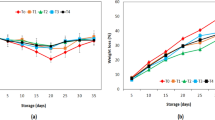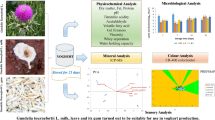Abstract
Gluten-free producers face significant technical and nutritional challenges, technological challenges due to lack of gluten. Cantaloupe by-products (CB) contain dietary fiber-associated phenolic compounds in different proportions. This study examined a new gluten-free donut (GFD) supplemented with antioxidant dietary fiber made from cantaloupe by-products (ADF-CB). Using response surface methodology (RSM), the effect of ADF-CB incorporation level (5–20 g/100 g rice flour) at particle sizes (PS) (75–500 μm) on pasting physicochemical and sensory properties of the experimental GFDs were investigated. The optimal conditions for producing high sensory scores to control were: 18 g/100 g rice flour at PS 438 µm (T4); 20 g/100 g rice flour at 288 µm (T1) and 13 g/100 g rice flour at 500 µm (T2). At these conditions, dietary fiber content increased by about fourfold higher than the control. Total phenolic content (TPC) increased by about ninefold higher than that of the control. Antioxidant properties exhibited as tested by IC50, which decrease by half-fold against the control. Oxygen radical absorbance capacity (ORAC) assay exhibited a significant increase by more than 8- folds higher than that of the control. Pasting properties values were increased as ADF-CB and PS increased except Setback viscosity (SBV). The use of ADF-CB with indicated PS to enhance the nutritional characteristics of GFD on an industrial scale as a health-promoting functional ingredient in gluten-free products.



Similar content being viewed by others
Abbreviations
- CB:
-
Cantaloupe by-products
- GFD:
-
Gluten-free donut
- ADF-CB:
-
Antioxidant dietary fiber made from cantaloupe by-products
- TPC:
-
Total phenolic content
- PS:
-
Particle sizes
- SBV:
-
Setback viscosity
- DW:
-
Dry weight
- WHC:
-
Water holding capacity
- OHC:
-
Oil holding capacity
- SC:
-
Swelling capacity
- CPIL:
-
Cantaloupe pomace incorporation level
References
FAOSTAT, Food and Agriculture Organization of the United Nations, FAOSTAT database (2015)
S. Mallek-Ayadi, N. Bahloul, N. Kechaou, Characterization, phenolic compounds and functional properties of Cucumis melo L. peels. Food Chem. 221, 1691–1697 (2017)
V.D. Capriles, J.A.G. Arêas, Novel approaches in gluten-free breadmaking: interface between food science, nutrition, and health. Comprehensive Rev. Food Sci. Food Safety 13(5), 871–890 (2014)
N. Pellegrini, C. Agostoni, Nutritional aspects of gluten-free products. J. Sci. Food Agric. 95(12), 2380–2385 (2015)
O. Radočaj, E. Dimić, R. Tsao, Effects of hemp (Cannabis sativa L.) seed oil press-cake and decaffeinated green tea leaves (Camellia sinensis) on functional characteristics of gluten-free crackers. J. Food Sci. 79(3), C318–C325 (2014)
F. Saura-Calixto, Dietary fiber as a carrier of dietary antioxidants: an essential physiological function. J. Agric. Food Chem. 59(1), 43–49 (2011)
J. Jones et al., British Society of Gastroenterology guidelines for the management of the irritable bowel syndrome. Gut 47(2), ii1–ii19 (2000)
Y. Liu et al., Effect of grinding methods on structural, physicochemical, and functional properties of insoluble dietary fiber from orange peel. Int. J. Polym. Sci. 2016, 1–7 (2016)
M.-M. Ma, T.-H. Mu, Effects of extraction methods and particle size distribution on the structural, physicochemical, and functional properties of dietary fiber from deoiled cumin. Food Chem. 194, 237–246 (2016)
Y. Zheng, Y. Li, Physicochemical and functional properties of coconut (Cocos nucifera L) cake dietary fibres: Effects of cellulase hydrolysis, acid treatment and particle size distribution. Food Chem. 257, 135–142 (2018)
Ö. Çelebican, I. Inci, N. Baylan, Modeling and optimization of formic acid adsorption by multiwall carbon nanotube using response surface methodology. J. Mol. Struct. 1203, 127312 (2020)
W.J. Sultan, Practical baking (Avi Pub. Co., 1981)
Horwitz, W., P. Chichilo, and H. Reynolds, Official Methods of Analysis of the Association of Official Agricultural Chemists (AOAC), AOAC International: Gaithersburg (MD, USA, 2012)
G. Shui, L.P. Leong, Residue from star fruit as valuable source for functional food ingredients and antioxidant nutraceuticals. Food Chem. 97(2), 277–284 (2006)
H.I. Ismail et al., Phenolic content and antioxidant activity of cantaloupe (Cucumis melo) methanolic extracts. Food Chem. 119(2), 643–647 (2010)
M. Namir et al., Optimizing the addition of functional plant extracts and baking conditions to develop acrylamide-free pita bread. J. Food Prot. 81(10), 1696–1706 (2018)
M. Kaur et al., Gluten free biscuits prepared from buckwheat flour by incorporation of various gums: physicochemical and sensory properties. LWT-Food Science and Technology 62(1), 628–632 (2015)
M. Namir, A.R. Suleiman, M.F.R. Hassanien, Characterization and functionality of alcohol insoluble solids from tomato pomace as fat substitute in low fat cake. Journal of Food Measurement and Characterization 9(4), 557–563 (2015)
AACC, C., , Approved methods of the American association of cereal chemists. Methods 54, 21 (2000)
M.A. Rabie et al., Acceleration of mackerel fish sauce fermentation via bromelain addition. Nutr. Food Sci. 49, 47–61 (2019)
F.T. Macagnan et al., Biological properties of apple pomace, orange bagasse and passion fruit peel as alternative sources of dietary fibre. Bioactive Carbohydrates and Dietary Fibre 6(1), 1–6 (2015)
T.H. Emaga et al., Effects of the stage of maturation and varieties on the chemical composition of banana and plantain peels. Food Chem. 103(2), 590–600 (2007)
M.M. Selani et al., Characterisation and potential application of pineapple pomace in an extruded product for fibre enhancement. Food Chem. 163, 23–30 (2014)
M. Viuda-Martos et al., Chemical, physico-chemical and functional properties of pomegranate (Punica granatum L.) bagasses powder co-product. J. Food Eng. 110(2), 220–224 (2012)
A. Llobera, J. Canellas, Dietary fibre content and antioxidant activity of Manto Negro red grape (Vitis vinifera): pomace and stem. Food Chem. 101(2), 659–666 (2007)
D.R. Morais et al., Antioxidant activity, phenolics and UPLC–ESI (–)–MS of extracts from different tropical fruits parts and processed peels. Food Res. Int. 77, 392–399 (2015)
T. Brito et al., Antimicrobial, antioxidant, volatile and phenolic profiles of cabbage-stalk and pineapple-crown flour revealed by GC-MS and UPLC-MSE. Food Chem. 339, 127882 (2020)
A.M. Goula, K.G. Adamopoulos, N.A. Kazakis, Influence of spray drying conditions on tomato powder properties. Drying Technol. 22(5), 1129–1151 (2004)
Z. Martins, O. Pinho, I. Ferreira, Food industry by-products used as functional ingredients of bakery products. Trends Food Sci. Technol. 67, 106–128 (2017)
A. Akesowan, Influence of konjac flour on foaming properties of milk protein concentrate and quality characteristics of gluten-free cookie. Int. J. Food Sci. Technol. 51(7), 1560–1569 (2016)
R. Wang et al., Pasting, thermal, and rheological properties of rice starch partially replaced by inulin with different degrees of polymerization. Food Hydrocolloids 92, 228–232 (2019)
J. Zheng et al., Effects of pectin on the pasting, rheological, and textural properties of lotus root starch. Starch-Stärke 71(3–4), 1700347 (2019)
M. Arslan et al., Complementing the dietary fiber and antioxidant potential of gluten free bread with guava pulp powder. Journal of Food Measurement and Characterization 11(4), 1959–1968 (2017)
E. Gallagher, T.R. Gormley, E.K. Arendt, Recent advances in the formulation of gluten-free cereal-based products. Trends Food Sci. Technol. 15(3–4), 143–152 (2004)
J. Korus et al., Influence of prebiotic additions on the quality of gluten-free bread and on the content of inulin and fructooligosaccharides. Food Sci. Technol. Int. 12(6), 489–495 (2006)
J. Korus et al., The impact of resistant starch on characteristics of gluten-free dough and bread. Food Hydrocolloids 23(3), 988–995 (2009)
A. Chauhan, D. Saxena, S. Singh, Total dietary fibre and antioxidant activity of gluten free cookies made from raw and germinated amaranth (Amaranthus spp.) flour. LWT-Food Science and Technology 63(2), 939–945 (2015)
C. Ajila et al., Mango peel powder: A potential source of antioxidant and dietary fiber in macaroni preparations. Innov. Food Sci. Emerg. Technol. 11(1), 219–224 (2010)
K. Xu et al., Okra seed and seedless pod: Comparative study of their phenolics and carbohydrate fractions and their impact on bread-making. Food Chem. 317, 126387 (2020)
Q.-M. Li et al., Influence of Adding Chinese Yam (Dioscorea opposita Thunb.) Flour on Dough Rheology, Gluten Structure, Baking Performance, and Antioxidant Properties of Bread. Foods 9(3), 256 (2020)
V. Benítez et al., Breads fortified with wholegrain cereals and seeds as source of antioxidant dietary fibre and other bioactive compounds. J. Cereal Sci. 82, 113–120 (2018)
R. Molinari et al., Tartary buckwheat malt as ingredient of gluten-free cookies. J. Cereal Sci. 80, 37–43 (2018)
L. Costantini et al., Development of gluten-free bread using tartary buckwheat and chia flour rich in flavonoids and omega-3 fatty acids as ingredients. Food Chem. 165, 232–240 (2014)
Acknowledgements
This work was supported by Zagazig University, Agriculture faculty, department of food science.
Funding
Funding provided by Dr. Mohammad Namir and Dr. Nourhan A Rabie.
Author information
Authors and Affiliations
Corresponding author
Ethics declarations
Conflict of interest
All authors declare that they have no conflict of interest.
Consent for participate
No conflict of interest exists in the submission of this manuscript. All the authors listed have participated in the research and approved the manuscript that is enclosed.
Consent for publication
All authors approved the paper for publication. All the authors agree to publish the paper in “Journal of Food Science and Technology.” If accepted, it will not be published elsewhere in the same form, in English or any other language, including electronically, without the copyright holder’s written consent.
Ethical approval
There is no ethics interest related to research.
Additional information
Publisher's Note
Springer Nature remains neutral with regard to jurisdictional claims in published maps and institutional affiliations.
Rights and permissions
About this article
Cite this article
Namir, M., Rabie, M.A. & Rabie, N.A. Physicochemical, pasting, and sensory characteristics of antioxidant dietary fiber gluten-free donut made from cantaloupe by-products. Food Measure 15, 5445–5459 (2021). https://doi.org/10.1007/s11694-021-01106-2
Received:
Accepted:
Published:
Issue Date:
DOI: https://doi.org/10.1007/s11694-021-01106-2




